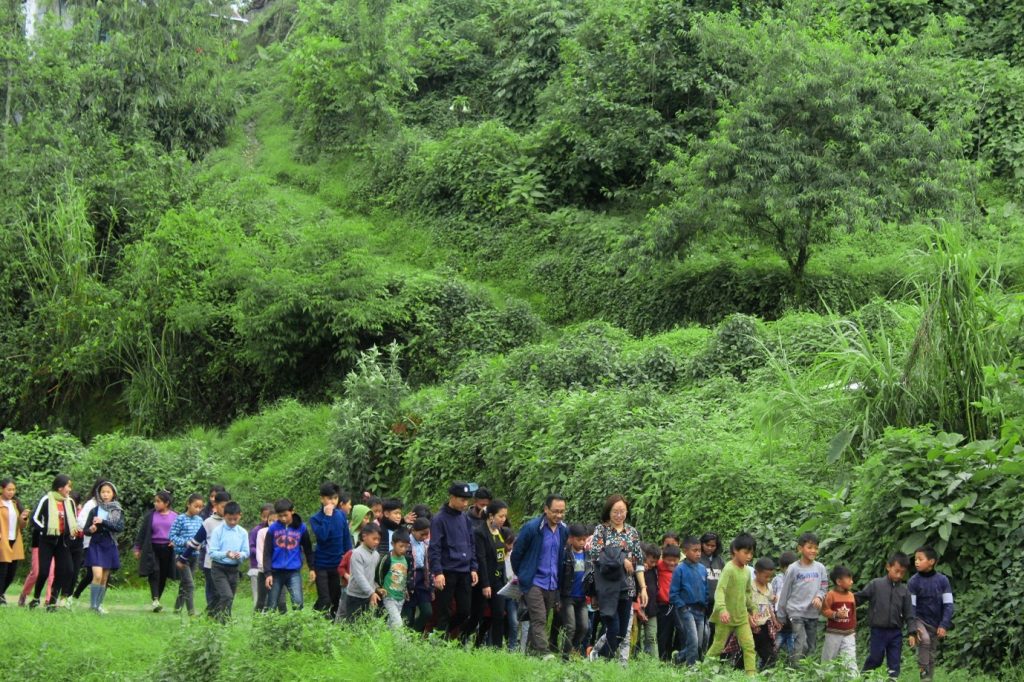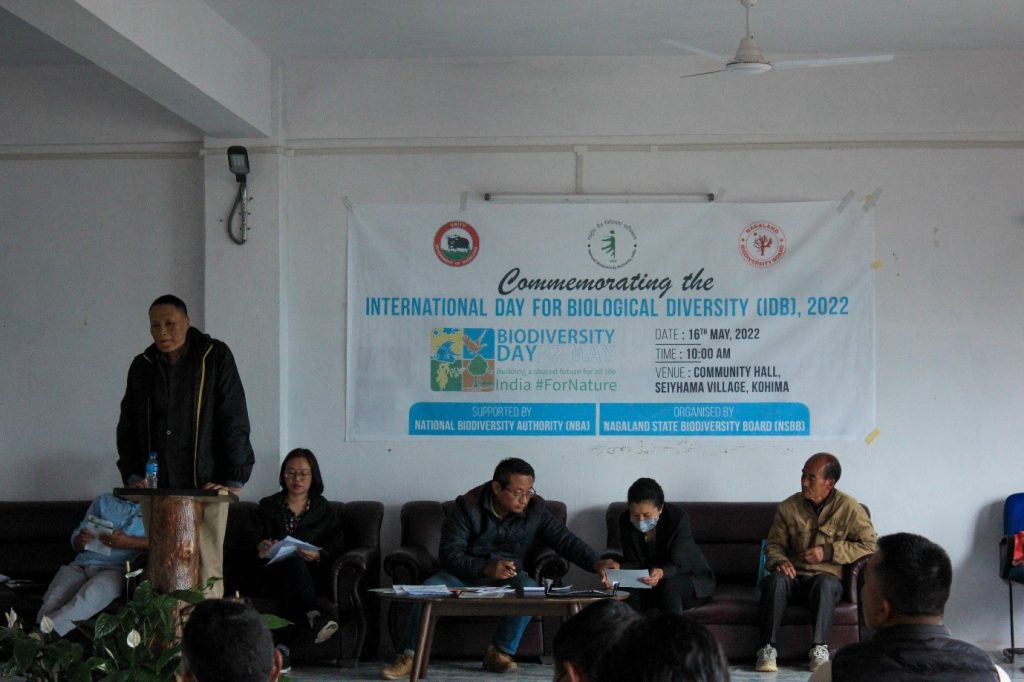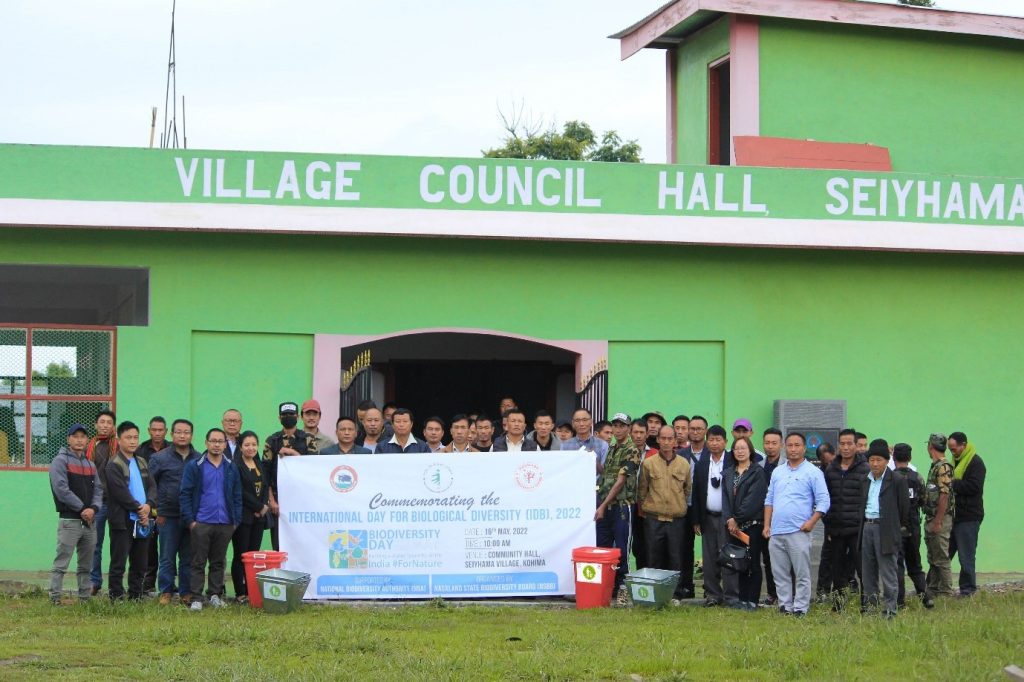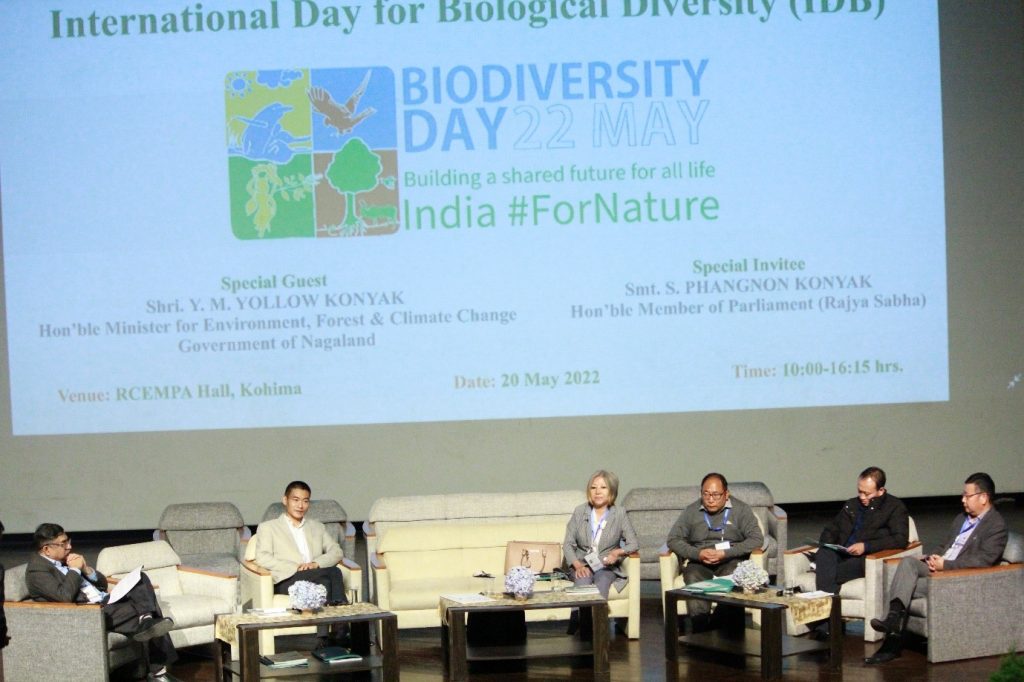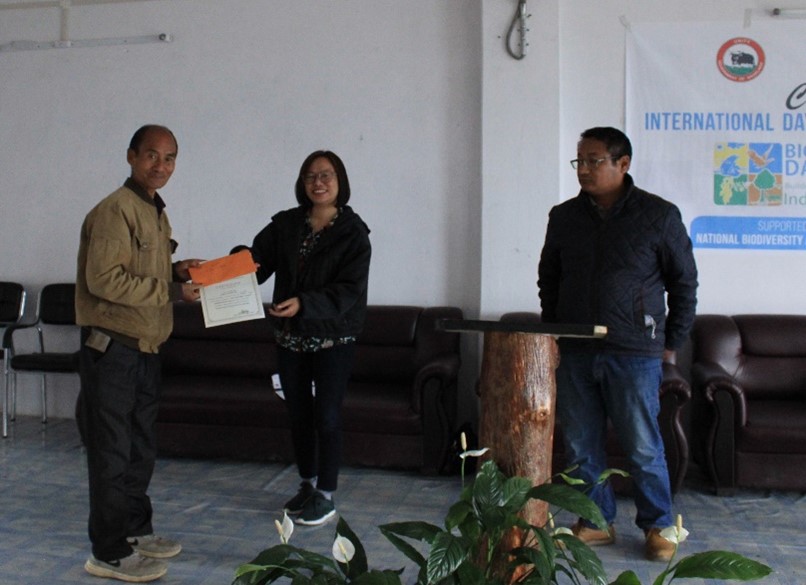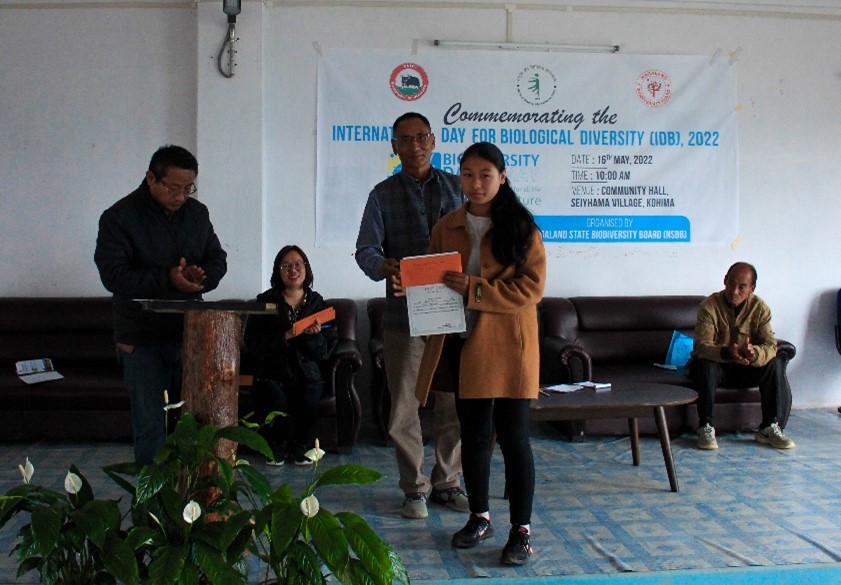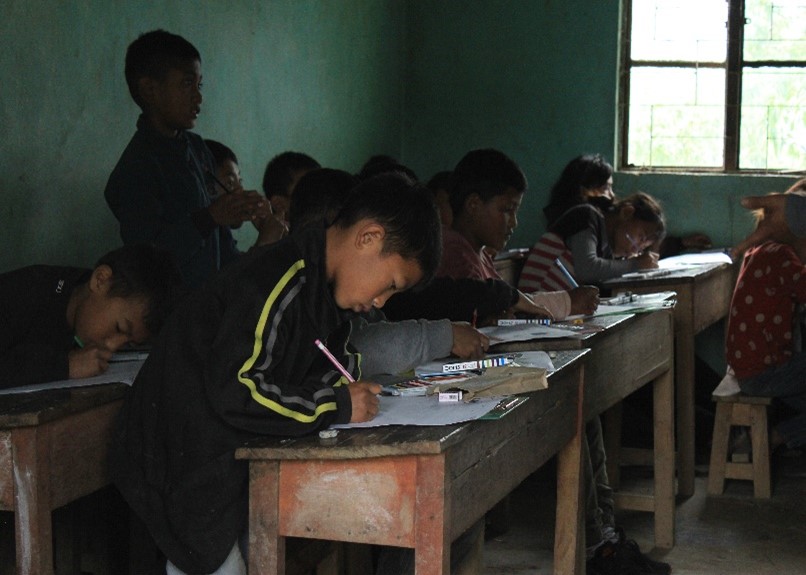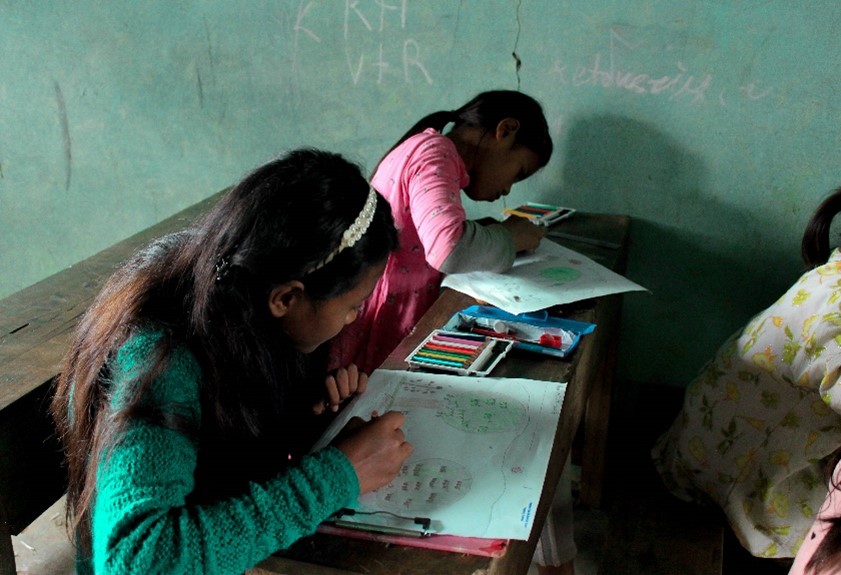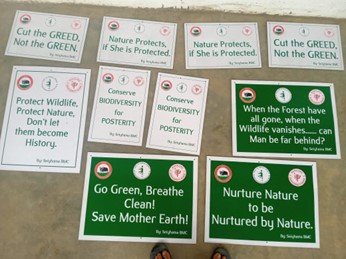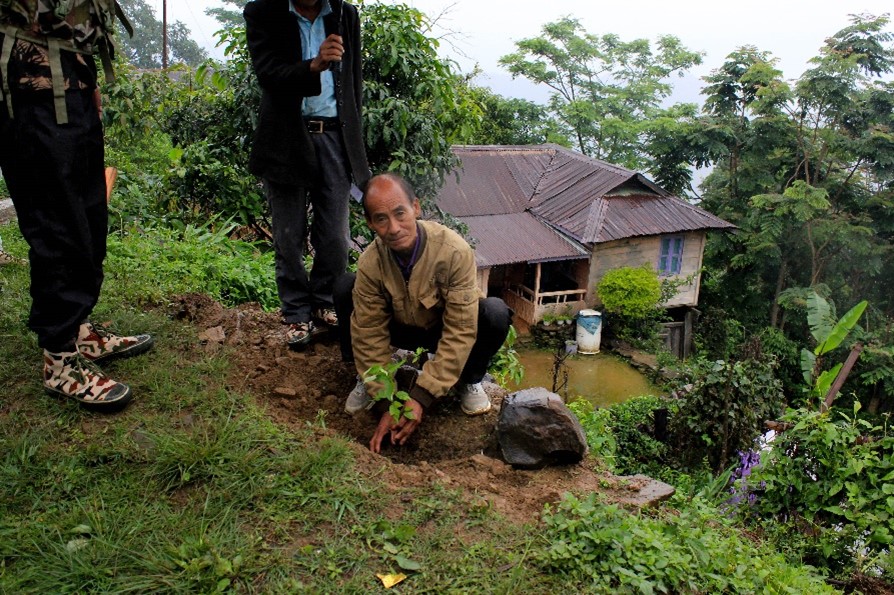The Nagaland State Biodiversity Board organized two events for Celebration of International Day for Biological Diversity (IDB), 2022 i.e. 1) Celebration with 10-12 BMCs at Seiyhama Village, Kohima and 2) State Level celebration in collaboration with GiZ India. The report of the event are as follows:
- Celebration with 10-12 BMCs at Seiyhama Village, Kohima :
The International Day for Biological Diversity (IDB), 2022 was commemorated on 16th May under the theme “Building a shared future for all life” at Seiyhama Village Council Hall, hosted by Seiyhama BMC. The Secretary of Seiyhama BMC chaired the occasion while the welcome address was delivered by Chairman of Seiyhama BMC.
NSBB Technical Staff shared on the theme “Building a shared future for all life” and stressed on the importance of biodiversity conservation keeping in mind the sustainable utilization of biodiversity so that the future generation is not deprived of the privilege to access its benefit and also to check on one’s action and strive towards achieving a shared and harmonious future.
A Story Narration Competition for BMCs on Biodiversity conservation efforts was conducted with a total of 12 (Twelve) BMCs participating in the competition. The highlight of the Competition was that each BMC have been initiating biodiversity conservation since its inception with mutual efforts from all the village stakeholders. Prizes and certificates were presented for the competition, wherein the first prize was bagged by Seiyhama BMC, second prize by Tuophema BMC and third prize bagged by Chiechama BMC. These BMCs were awarded for performing exemplary activities towards biodiversity conservation in consensus with participation of local communities.
Simultaneously, Painting Competition was conducted for School students in Junior (Class-1 to 5) & Senior (Class 6 to 8) Categories followed by Nature Walk for students of Class 1-8 with Open Quiz Competition. Awards in Cash and certificates were distributed to all the winners for the painting competition and attractive events at the end of the event.
To commemorate the meaningful event, plantation of local tree species was planted by Chairman of Seiyhama BMC and Savinuo Kikhi, Range Officer, NSBB.
Signages with different messages were presented to Seiyhama BMC for setting up at ideal locations.
All together about 150 participants from various stakeholders, students, teachers, BMCs and village leaders participated in the event.
- State Level celebration in collaboration with GiZ India
The International Day for Biological Diversity (IDB), 2022 was celebrated on 20 May under the theme ‘Building a shared future for all life –India for Nature at RCEMPA Hall, Kohima. It was jointly organised by Nagaland State Biodiversity Board (NSBB) and the Deutsche Gesellschaft für Internationale Zusammenarbeit (GIZ) GmbH. The revised Nagaland State Biodiversity Strategy Action Plan (NSBSAP) supported by the global project under the Indo-German development cooperation project “Biodiversity and Ecosystem Services in Agrarian Landscapes (IKI-Biodiv)” implemented by GIZ and commissioned by the German Federal Ministry for the Environment, Nature Conservation, Nuclear Safety and Consumer Protection (BMUV) was also released during the celebration.
The Chairperson was Shri Dharmendra Prakash, IFS, PCCF and Head of Forest Force. There were two sessions for the event: (1) Launching of the Revised Nagaland State Biodiversity Strategy and Action Plan (NSBSAP); and (2) Technical Session with panel discussion on: Way Forward for Nagaland State Biodiversity Strategy and Action Plan.
The welcome address was delivered by Shri Supongnukshi, IFS, Member Secretary, NSBB. While the keynote address was delivered by Satya Prakash Tripathi, IFS (Retd), Chairman, NSBB.
A special performance on Folk song based on sustainable conservation was performed by local artists Pfüchazünuoko.
Shri Farhad Vania, Country Office, GIZ, India in his address shared that GIZ has been in Nagaland for over a decade, and has been working in biodiversity areas.
He said that it was not possible for a country to try and resolve the problems itself, but needed international cooperation. In this regard, a Cabinet Consultation of Head of States was held where Prime Minister, Narendra Modi met Chancellor, Germany, Olaf Scholz on May 2, 2022 and entered into Indo-German Green and Sustainable Development Partnership, for future development and gives direction especially in Sustainable Development Goals.
Addressing the gathering, Dr. Antje C. Berger, Counsellor, Head of Environmental Affairs, German Embassy, New Delhi stated that biodiversity remained the key answer to several sustainable development challenges. With two of the world’s 36 Biodiversity Hotspots present in North Eastern region, and Nagaland located in the Indo Burma biodiversity hotspot, she termed NSBSAP as a step towards maintaining the unique landscape and management. She also added that the agricultural practices can have positive effects on biodiversity and ecosystem services, that the enhanced shifting cultivation practices have the potential to promote biodiversity and ecosystem services, permanently improve agricultural production and resilience to the effects of climate change.
Shri James Pangsang Kongkal Sangma, Minister for Environment, Forest and Climate Change, Meghalaya also delivered a special video message on IDB and conservation; and further congratulated Nagaland on the release of revised NSBSAP.
Launching the NSBSAP, the Special Guest, Shri Y.M Yollow Konyak, Minister for Environment, Forest and Climate Change, Nagaland said that the state harbours a large number of plant species which are endemic to the State or the North East part of India. He said that policy and planning mechanisms in every sphere of development should accommodate the aspect of biodiversity conservation. He noted that India is one of 175 countries that are signatories of the Convention on Biological Diversity (CBD), and hence there is need to work together and establish certain policies and guidelines to achieve all the objectives of the convention while also protecting dwindling biodiversity resources. All signatories of the CBD framed Strategies and Action Plans for obtaining the objectives of the. In 1999, the Ministry of Environment, Forest & Climate Change, Government of India prepared the national policy and macro level action strategies on biodiversity through a consultation process for effective implementation of the CBD. As a follow up of the macro-level action strategies on biodiversity, detailed action plans on biodiversity were made at the national level and state level. The National Biodiversity Strategy and Action Plan was prepared in 2008. The Department of Environment, Forest & Climate Change and the Centre of Environment Studies, North Eastern Hill University (NEHU), Shillong in 2005, jointly prepared the state level Biodiversity Strategy and Action Plan for Nagaland. The Minister stated that the revised Nagaland Biodiversity Strategy and Action Plan was with the financial support of the GIZ and with technical support of the Foundation for Ecological Security (FES). The revision of the Nagaland Biodiversity Strategy and Action Plan was supported by the “Biodiversity and Ecosytem Services in Agrarian Landscapes (IKI Biodiv)” implemented by the GIZ.
The revised plan includes identification of 12 (twelve) Nagaland Biodiversity Targets (NBT), based on the revised priorities underlined for the National Biodiversity Targets of 2008 (and the addendum in 2014) to form the National Biodiversity Action Plan (NBAP). Each of these National Targets in turn has been derived in relation to global priorities underlined by the Aichi Targets and Sustainable Development Goals. The timeline for moving towards achieving these targets have been kept at five years, with 2026 being the cut off year when it can be evaluated again.
The 12 (twelve) Nagaland Biodiversity Targets (NBT) include:
NBT-1: By 2026, a significant proportion of the State’s population, especially the youth, is aware of the values of biodiversity and the steps they can take to conserve and use it sustainably.
NBT-2: By 2026, values of biodiversity are integrated into state planning processes, development programmes and poverty alleviation strategies.
NBT-3: Strategies for reducing rate of degradation, fragmentation and loss of all natural habitats are finalized and actions put in place by 2026 for environmental amelioration and human well-being.
NBT-4: By 2026, invasive species and pathways are identified and strategies to manage them developed so that populations of prioritized invasive species are managed.
NBT-5: By 2026, measures are adopted for sustainable management of agriculture, forestry and fisheries.
NBT-6: Ecologically representative areas under terrestrial and inland water, those of particular importance for species, biodiversity and ecosystem services, are conserved effectively and equitably, based on protected area designation and management and other area-based conservation measures and are integrated into the wider landscapes by 2026.
NBT-7: By 2026, genetic diversity of cultivated plants, farm livestock, and their wild relatives, including other socio-economically as well as culturally valuable species, is maintained, and strategies have been developed and implemented for minimizing genetic erosion and safeguarding their genetic diversity.
NBT-8: By 2026, ecosystem services, especially those relating to water, human health, livelihoods and well-being, are enumerated and measures to safeguard them are identified, taking into account the needs of women and local communities, particularly the poor and vulnerable sections.
NBT-9: Access to Genetic Resources and the Fair and Equitable Sharing of Benefits arising from their utilization as per the Nagoya Protocol are operational, consistent with national legislations.
NBT-10: By 2026, an effective, participatory and updated National Biodiversity Action Plan is made operational at different levels of governance.
NBT-11: By 2026, State wide initiatives using communities’ traditional knowledge relating to biodiversity are strengthened, with a view to protecting this knowledge in accordance with national legislations and international obligations.
NBT-12: By 2026, opportunities to increase the availability of financial, human and technical resources to facilitate effective implementation of the Strategic Plan and State Targets are identified and the Strategy for Resource Mobilization is adopted.
During the Technical Session, a detailed presentation on NSBSAP was delivered by the Foundation for Ecological Security (FES); and Dr Suhas Nimbalkar presented the case studies on BSAP and role of BMCs.
The Panel discussion was Chaired by Shri Dharmendra Prakash, IFS, PCCF and Head of Forest Force and the panellist included: (1) Prof. Neizo Puro, Nagaland University (2) Ms. Imtienla Ao, IFS, Dy. Director General of Forest, MoEFCC, RO, Shillong (3) Shri Y. Nuklu Phom, Chairman of Lemsachenlok Society of Yaongimchen Village and (4) Shri Ivan Zhimomi, Team Leader TVBCLN. The discussion was based on the present conservation efforts, NSBSAP, sustainable Jhum conservation at the grass root level.
The words of gratitude was delivered by Shri Kenneth M. Pala, Senior Advisor, IKI Bidodiv, GIZ.
